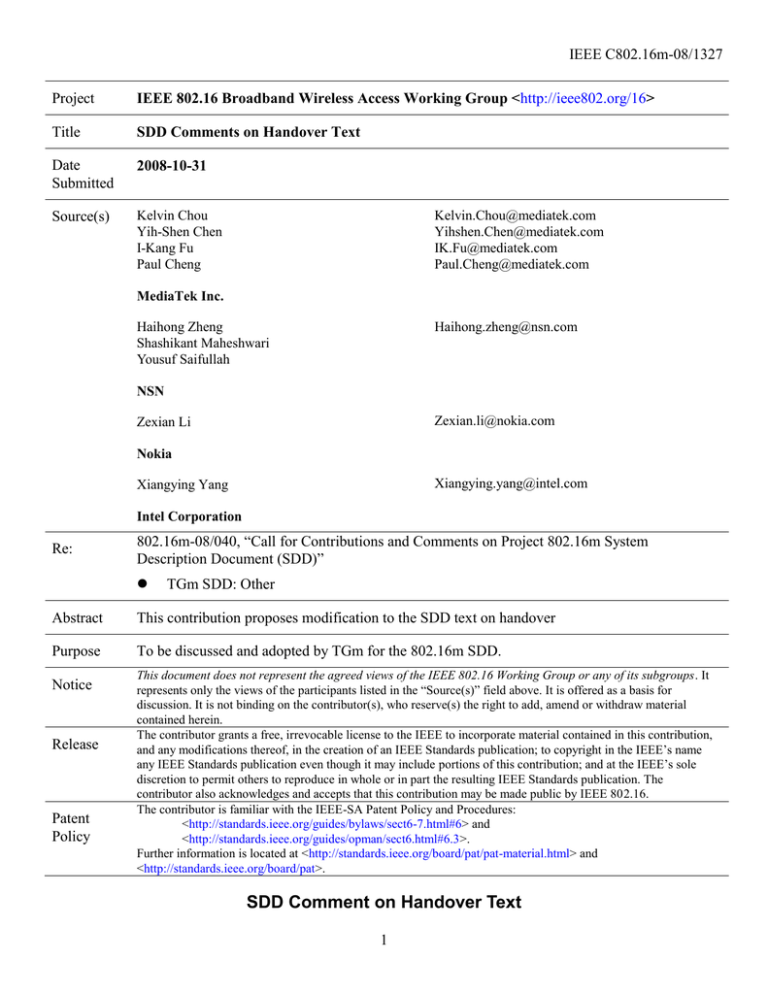IEEE C802.16m-08/1327 Project Title
advertisement

IEEE C802.16m-08/1327 Project IEEE 802.16 Broadband Wireless Access Working Group <http://ieee802.org/16> Title SDD Comments on Handover Text Date Submitted 2008-10-31 Source(s) Kelvin Chou Yih-Shen Chen I-Kang Fu Paul Cheng Kelvin.Chou@mediatek.com Yihshen.Chen@mediatek.com IK.Fu@mediatek.com Paul.Cheng@mediatek.com MediaTek Inc. Haihong Zheng Shashikant Maheshwari Yousuf Saifullah Haihong.zheng@nsn.com NSN Zexian.li@nokia.com Zexian Li Nokia Xiangying.yang@intel.com Xiangying Yang Intel Corporation Re: 802.16m-08/040, “Call for Contributions and Comments on Project 802.16m System Description Document (SDD)” TGm SDD: Other Abstract This contribution proposes modification to the SDD text on handover Purpose To be discussed and adopted by TGm for the 802.16m SDD. Notice Release Patent Policy This document does not represent the agreed views of the IEEE 802.16 Working Group or any of its subgroups. It represents only the views of the participants listed in the “Source(s)” field above. It is offered as a basis for discussion. It is not binding on the contributor(s), who reserve(s) the right to add, amend or withdraw material contained herein. The contributor grants a free, irrevocable license to the IEEE to incorporate material contained in this contribution, and any modifications thereof, in the creation of an IEEE Standards publication; to copyright in the IEEE’s name any IEEE Standards publication even though it may include portions of this contribution; and at the IEEE’s sole discretion to permit others to reproduce in whole or in part the resulting IEEE Standards publication. The contributor also acknowledges and accepts that this contribution may be made public by IEEE 802.16. The contributor is familiar with the IEEE-SA Patent Policy and Procedures: <http://standards.ieee.org/guides/bylaws/sect6-7.html#6> and <http://standards.ieee.org/guides/opman/sect6.html#6.3>. Further information is located at <http://standards.ieee.org/board/pat/pat-material.html> and <http://standards.ieee.org/board/pat>. SDD Comment on Handover Text 1 IEEE C802.16m-08/1327 Kelvin Chou,Yih-Shen Chen,I-Kang Fu,Paul Cheng MediaTek Haihong Zheng, Shashikant Maheshwari, Yousuf Saifullah NSN Zexian Li Nokia Xiangying Yang Intel Corporation Introduction The following aspects of intra-16m HO scheme haven’t been fully addressed in the current SDD text. 1) The HO scheme where MS maintains communication with serving BS during network entry, The multiplexing scheme of network re-entry signaling with target BS and communications with serving BS needs to be further defined. 2) For the HO scheme where MS maintains communication with serving BS during network entry, the associated parameters of the multiplexing scheme need to be provided to the target BS from the serving BS during HO preparation phase. Such aspect is not addressed in section 10.3.2.2.2. 3) HO cancellation signaling is not required for the HO scheme where MS maintains communication with serving BS during network entry, because the T-BS can inform S-BS in the case of network entry failure, and the S-BS can clear MS's HO context and stops correspondent sleep interval operation if needed. Since MS stays connected with the S-BS, there is no need for MS to send any HO cancellation signaling to indicate to the S-BS that it is back. Such aspect is clarified in section 10.3.2.2.4. Proposed SDD Text Modification Remedy 1 [In 80216m-08_003r5, Section 10.3.2.2.2, modify the following text] ------------------------------- Text Start ------------------------------------------------------------------------------------ 10.3.2.2.2 HO preparation During HO preparation phase, the serving BS selects communicate with target BS(s) for HO. The target BS may obtain MS information from the serving BS via backbone network for HO optimization. Ranging with target BS prior or during HO preparation is FFS. If ranging with target BS not performed prior to or during HO preparation, dedicated ranging resource (e.g. code, channel, etc.) at target BS may be reserved for the MS to facilitate non-contention-based HO ranging. Information regarding MS identity (e.g. TEK, STID, FIDs, etc.), may be pre-updated during HO preparation. Any mismatched system information between MS and the target BS, if detected, may be provided to the MS by the Serving BS during HO preparation. HO preparation phase completes when serving BS informs the MS of its handover decision via a HO Command control signaling. The control signaling may include dedicate ranging resource allocation and resource pre allocations for MS at target BS for optimized network re-entry. The control signaling includes an action time for 2 IEEE C802.16m-08/1327 the MS to start network re-entry at the target BS and an indication whether MS should maintain communication with serving BS during network re-entry. In the case that MS maintains communication with serving BS during network reentry, the parameters associated with the scheme of multiplexing transmission with serving and target BS are determined by serving BS based on the MS capability and negotiated between the serving and target BSs. ------------------------------- Text End ------------------------------------------------------------------------------------ Remedy 2 [In 80216m-08_003r5, Section 10.3.2.2.3, modify the following text] ------------------------------- Text Start ------------------------------------------------------------------------------------ 10.3.2.2.3 HO execution At the action time specified in the HO command control signaling, the MS performs network re-entry at the target BS. If communication is not maintained between MS and serving BS during network re-entry at the target BS, serving BS stops allocating resources to MS for transmission at action time. If directed by serving BS via HO Command control signaling, the MS performs network re-entry with the target BS at action time while continuously communicates with serving BS. However, the MS stops communication with serving BS after network re-entry at target BS is completed. In addition, MS cannot exchange data with target BS prior to completion of network re-entry. Multiplexing of network re-entry signaling with target BS and communications with serving BS is FFS. done by using negotiated intervals with serving BS for network reentry signaling with target BS, and the remaining opportunities with serving BS for data communication. If the negotiated interval is set to 0, the MS communicates with the serving BS continuously while concurrently performing network re-entry with the target BS. ------------------------------- Text End ------------------------------------------------------------------------------------ Remedy 3 [In 80216m-08_003r5, Section 10.3.2.2.4, modify the following text] ------------------------------- Text Start ------------------------------------------------------------------------------------ 10.3.2.2.4 HO cancellation After HO is initiated, the MS may cancel HO at any phase during HO procedure by sending a HO cancellation message to the serving BS. After the HO cancellation message is processed, the MS and serving BS resume their normal operation. The dedicated ranging code assignment for transmitting HO cancellation message is FFS. In the case that MS maintains communication with serving BS during network reentry, no HO cancellation signaling is needed from MS. ------------------------------- Text End ------------------------------------------------------------------------------------ 3

